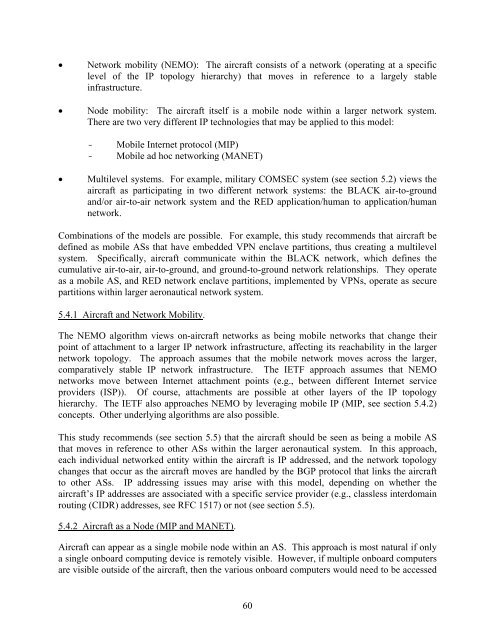Local Area Networks (LANs) in Aircraft - FTP Directory Listing - FAA
Local Area Networks (LANs) in Aircraft - FTP Directory Listing - FAA
Local Area Networks (LANs) in Aircraft - FTP Directory Listing - FAA
You also want an ePaper? Increase the reach of your titles
YUMPU automatically turns print PDFs into web optimized ePapers that Google loves.
• Network mobility (NEMO): The aircraft consists of a network (operat<strong>in</strong>g at a specific<br />
level of the IP topology hierarchy) that moves <strong>in</strong> reference to a largely stable<br />
<strong>in</strong>frastructure.<br />
• Node mobility: The aircraft itself is a mobile node with<strong>in</strong> a larger network system.<br />
There are two very different IP technologies that may be applied to this model:<br />
- Mobile Internet protocol (MIP)<br />
- Mobile ad hoc network<strong>in</strong>g (MANET)<br />
• Multilevel systems. For example, military COMSEC system (see section 5.2) views the<br />
aircraft as participat<strong>in</strong>g <strong>in</strong> two different network systems: the BLACK air-to-ground<br />
and/or air-to-air network system and the RED application/human to application/human<br />
network.<br />
Comb<strong>in</strong>ations of the models are possible. For example, this study recommends that aircraft be<br />
def<strong>in</strong>ed as mobile ASs that have embedded VPN enclave partitions, thus creat<strong>in</strong>g a multilevel<br />
system. Specifically, aircraft communicate with<strong>in</strong> the BLACK network, which def<strong>in</strong>es the<br />
cumulative air-to-air, air-to-ground, and ground-to-ground network relationships. They operate<br />
as a mobile AS, and RED network enclave partitions, implemented by VPNs, operate as secure<br />
partitions with<strong>in</strong> larger aeronautical network system.<br />
5.4.1 <strong>Aircraft</strong> and Network Mobility.<br />
The NEMO algorithm views on-aircraft networks as be<strong>in</strong>g mobile networks that change their<br />
po<strong>in</strong>t of attachment to a larger IP network <strong>in</strong>frastructure, affect<strong>in</strong>g its reachability <strong>in</strong> the larger<br />
network topology. The approach assumes that the mobile network moves across the larger,<br />
comparatively stable IP network <strong>in</strong>frastructure. The IETF approach assumes that NEMO<br />
networks move between Internet attachment po<strong>in</strong>ts (e.g., between different Internet service<br />
providers (ISP)). Of course, attachments are possible at other layers of the IP topology<br />
hierarchy. The IETF also approaches NEMO by leverag<strong>in</strong>g mobile IP (MIP, see section 5.4.2)<br />
concepts. Other underly<strong>in</strong>g algorithms are also possible.<br />
This study recommends (see section 5.5) that the aircraft should be seen as be<strong>in</strong>g a mobile AS<br />
that moves <strong>in</strong> reference to other ASs with<strong>in</strong> the larger aeronautical system. In this approach,<br />
each <strong>in</strong>dividual networked entity with<strong>in</strong> the aircraft is IP addressed, and the network topology<br />
changes that occur as the aircraft moves are handled by the BGP protocol that l<strong>in</strong>ks the aircraft<br />
to other ASs. IP address<strong>in</strong>g issues may arise with this model, depend<strong>in</strong>g on whether the<br />
aircraft’s IP addresses are associated with a specific service provider (e.g., classless <strong>in</strong>terdoma<strong>in</strong><br />
rout<strong>in</strong>g (CIDR) addresses, see RFC 1517) or not (see section 5.5).<br />
5.4.2 <strong>Aircraft</strong> as a Node (MIP and MANET).<br />
<strong>Aircraft</strong> can appear as a s<strong>in</strong>gle mobile node with<strong>in</strong> an AS. This approach is most natural if only<br />
a s<strong>in</strong>gle onboard comput<strong>in</strong>g device is remotely visible. However, if multiple onboard computers<br />
are visible outside of the aircraft, then the various onboard computers would need to be accessed<br />
60
















